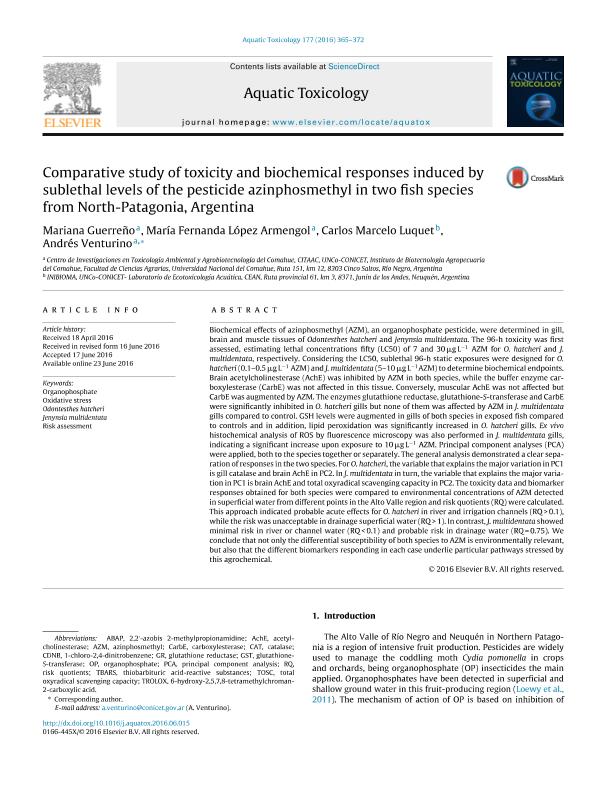Artículo
Comparative study of toxicity and biochemical responses induced by sublethal levels of the pesticide azinphosmethyl in two fish species from North-Patagonia, Argentina
Fecha de publicación:
08/2016
Editorial:
Elsevier Science
Revista:
Aquatic Toxicology
ISSN:
0166-445X
Idioma:
Inglés
Tipo de recurso:
Artículo publicado
Clasificación temática:
Resumen
Biochemical effects of azinphosmethyl (AZM), an organophosphate pesticide, were determined in gill, brain and muscle tissues of Odontesthes hatcheri and Jenynsia multidentata. The 96-h toxicity was first assessed, estimating lethal concentrations fifty (LC50) of 7 and 30 μg L−1 AZM for O. hatcheri and J. multidentata, respectively. Considering the LC50, sublethal 96-h static exposures were designed for O. hatcheri (0.1–0.5 μg L−1 AZM) and J. multidentata (5–10 μg L−1AZM) to determine biochemical endpoints. Brain acetylcholinesterase (AchE) was inhibited by AZM in both species, while the buffer enzyme carboxylesterase (CarbE) was not affected in this tissue. Conversely, muscular AchE was not affected but CarbE was augmented by AZM. The enzymes glutathione reductase, glutathione-S-transferase and CarbE were significantly inhibited in O. hatcheri gills but none of them was affected by AZM in J. multidentata gills compared to control. GSH levels were augmented in gills of both species in exposed fish compared to controls and in addition, lipid peroxidation was significantly increased in O. hatcheri gills. Ex vivo histochemical analysis of ROS by fluorescence microscopy was also performed in J. multidentata gills, indicating a significant increase upon exposure to 10 μg L−1 AZM. Principal component analyses (PCA) were applied, both to the species together or separately. The general analysis demonstrated a clear separation of responses in the two species. For O. hatcheri, the variable that explains the major variation in PC1 is gill catalase and brain AchE in PC2. In J. multidentata in turn, the variable that explains the major variation in PC1 is brain AchE and total oxyradical scavenging capacity in PC2. The toxicity data and biomarker responses obtained for both species were compared to environmental concentrations of AZM detected in superficial water from different points in the Alto Valle region and risk quotients (RQ) were calculated. This approach indicated probable acute effects for O. hatcheri in river and irrigation channels (RQ > 0.1), while the risk was unacceptable in drainage superficial water (RQ > 1). In contrast, J. multidentata showed minimal risk in river or channel water (RQ < 0.1) and probable risk in drainage water (RQ = 0.75). We conclude that not only the differential susceptibility of both species to AZM is environmentally relevant, but also that the different biomarkers responding in each case underlie particular pathways stressed by this agrochemical.
Archivos asociados
Licencia
Identificadores
Colecciones
Articulos(CCT - PATAGONIA NORTE)
Articulos de CTRO.CIENTIFICO TECNOL.CONICET - PATAGONIA NORTE
Articulos de CTRO.CIENTIFICO TECNOL.CONICET - PATAGONIA NORTE
Articulos(INIBIOMA)
Articulos de INST. DE INVEST.EN BIODIVERSIDAD Y MEDIOAMBIENTE
Articulos de INST. DE INVEST.EN BIODIVERSIDAD Y MEDIOAMBIENTE
Citación
Guerreño, Mariana; Lopez Armengol, Maria Fernanda; Luquet, Carlos Marcelo; Venturino, Andres; Comparative study of toxicity and biochemical responses induced by sublethal levels of the pesticide azinphosmethyl in two fish species from North-Patagonia, Argentina; Elsevier Science; Aquatic Toxicology; 177; 8-2016; 365-372
Compartir
Altmétricas




